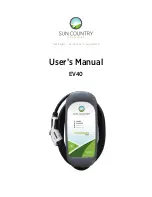
SCHEIBER
Printed 09/99
SCHEIBER
SA
- 85120 SAINT PIERRE DU CHEMIN - FRANCE
Tél : 02 51 51 73 21
Fax : 02 51 51 75 03
Tél international : + 33 2 51 51 73 21
Fax international : + 33 2 51 51 75 03
Email. : [email protected]
Internet : www.scheiber.fr
30.65100.84 BIP- CHARGER IU 10 A with fuses.
With the BIP charger (box for Interconnection and Protection) you can charge a battery. At the same time, the
product supplies the 12V uses through the battery and the 230 V circuits.
Please read these instructions before connecting and using the BIP charger. Considering the warnings
mentioned in this booklet, the manufacturer could not be held responsible of damages caused to people or
goods due to incorrect uses.
PLEASE KEEP THESE INSTRUCTIONS CAREFULLY
This booklet describes how to settle and use the BIP – Charger.
The charger must only be used for the purpose specified by the manufacturer
After unpacking the charger, please make sure that it is complete and in good state. If you have doubts, make it
check by someone with the required qualifications.
Do not let the packing within reach of children or of non-responsible persons.
Table of contents:
I
GENERAL SAFETY AND INSTALLATION INFORMATION
II
WIRING
III
INSTALLATION AND PUTTING INTO OPERATION
IV
MAINTENANCE
V
TECHNICAL DATA
VI
PARTICULARITIES.
I
GENERAL SAFETY AND INSTALLATION INFORMATION
BE CAREFUL: Always disconnect the charger from the 230V before any operation.
It must be settled and fixed (see chapter « installation and putting into operation »).
Disconnect the supply before connecting or disconnecting the battery.
Do not use the charger when case or wires are damaged
The charger must not be operated in a damp or wet environment.
WARNINGS: During the battery charge, avoid flames and sparks, and make sure that it is placed in a good
ventilated place during the charge. Explosive gas.
Use the charger inside or do not expose it to the rain.
When replacing an output fuse, comply with the calibre given in the data.
In case of an installation of the product within a caravan, the connections on the mains have to be done according
the rules of the country.
II
ABOUT THE CABLES
- If cables have to be inserted through metal walls, use a cable duct or cable bushes.
- Do not lay wires loose or with sharp bends on electrically conductive materials,
- Do not lay together 230V mains and 12V DC cables in the same cable duct,
- The specified minimum cable cross-section must be complied with (see chapter « cable section »),
- secure cables properly,
- lay cables in a such way that they are not exposed to the risk of damage,
- To disconnect the device, turn « OFF » the mains and unplug the product. It must always be within hand reach.
- When the 230V supply wire is damaged, it must be replaced by our after sales department or by someone with
the required qualifications.
CABLES SECTIONS
The mounting of a magneto-thermic circuit breaker is necessary to protect the 230V supplying.
-
If wires’ length there and back (+ and -) is inferior to 10 meters, then the wires’ section must be 2,5mm
2
.
-
If wires’ length there and back (+ and -) is between 10 and 20 meters; then wires’ section has to be 4mm
2
.























